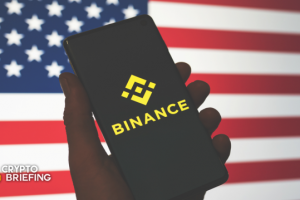
Key Takeaways
Terra developer Tobias Andersen submitted a proposal yesterday for the Terra Classic community to work on repegging USTC to $1.
Andersen claims the repeg could be accomplished by attracting new businesses to the Terra Classic blockchain.
There are several reasons to doubt the viability of the plan, not least of which being its lack of an actual price stabilizing mechanism.
Share this article
USTC shot up 57% shortly after a Terra developer published a proposal calling for the community to work on bringing the former stablecoin back to its $1 peg—and keep it there.
Back From the Dead?
The Terra Classic community is hoping its failed stablecoin will make a comeback.
Terra developer Tobias Andersen published a Medium post yesterday making the case that the Terra Classic community (or “Lunatics” as they style themselves) should aim to push the ecosystem’s original stablecoin, TerraClassicUSD (USTC), back to its $1 peg.
The post caused USTC to soar a little more than 57% on Binance (the exchange with the most liquidity for the token), from $0.029 to $0.045. The token then proceeded to drop 12% and is trading at $0.039 at the time of writing. Per CoinGecko data, USTC is up 592% since it bottomed at $0.006 on June 18.
The algorithmic stablecoin, formerly known as UST, used to be Terra’s flagship product. An algorithm allowed users to mint 1 UST by burning $1 worth of LUNA (Terra’s native governance token and balancing mechanism for UST) and vice versa. The mechanism helped turn both LUNA and UST into two of crypto’s biggest tokens by market capitalization during the 2021 bull run. However, it also created a negative feedback loop when the stablecoin broke its peg in early May, and investors lost confidence in it. UST, LUNA, and the rest of Terra ecosystem collapsed, directly wiping out more than $40 billion of value from the crypto market in a matter of days.
Practical Concerns
While Andersen’s goal is ambitious, the content of his proposal is threadbare.
Andersen claims that a USTC repeg could be accomplished by incentivizing new businesses to use Terra Classic’s existing blockchain infrastructure. To that end, Andersen suggests implementing a burning mechanism for USTC, lock-up periods for LUNC staking, and creating partial swap and partitioned pool mechanisms (which could then be taxed). But the Terra developer fails to explain exactly how even a successful implementation of these features would be helpful in any way for USTC to regain its peg.
There are currently three main types of stablecoins. Some, like USDT and USDC, are backed by reserves made of government-issued currencies, like the U.S. dollar or the euro. Others, like MakerDAO’s DAI, use an overcollateralization process: users can deposit ETH or other cryptocurrencies and mint DAI against their assets. Finally, algorithmic stablecoins, such as the old UST, are usually backed by algorithmic mechanisms that attempt to direct market forces toward stabilizing the coin’s price.
But that $1 goal is likely also out of reach. The proposal seems to conflate the idea of network activity on the Terra Classic blockchain with a price appreciation for USTC. Unfortunately, that will not be enough. At most, network activity may increase the price of the ecosystem’s native token, LUNC, but unless a mechanism is put in place for USTC to capture some of the value brought to the Terra blockchain, there are no fundamental reasons for the former stablecoin’s price to change.
It also does not address how USTC would consistently maintain its peg without becoming a purely speculative asset.
It’s not the first time Lunatics have pinned their hopes on dubious plans. The community recently rallied around the idea that the LUNC token, which is trading at $0.00029 today, could also reach $1. The token would need to surpass Bitcoin’s own market capitalization several times over for that to happen.
Disclaimer: At the time of writing, the author of this piece owned BTC, ETH, and several other cryptocurrencies.
Share this article
The information on or accessed through this website is obtained from independent sources we believe to be accurate and reliable, but Decentral Media, Inc. makes no representation or warranty as to the timeliness, completeness, or accuracy of any information on or accessed through this website. Decentral Media, Inc. is not an investment advisor. We do not give personalized investment advice or other financial advice. The information on this website is subject to change without notice. Some or all of the information on this website may become outdated, or it may be or become incomplete or inaccurate. We may, but are not obligated to, update any outdated, incomplete, or inaccurate information.
You should never make an investment decision on an ICO, IEO, or other investment based on the information on this website, and you should never interpret or otherwise rely on any of the information on this website as investment advice. We strongly recommend that you consult a licensed investment advisor or other qualified financial professional if you are seeking investment advice on an ICO, IEO, or other investment. We do not accept compensation in any form for analyzing or reporting on any ICO, IEO, cryptocurrency, currency, tokenized sales, securities, or commodities.
See full terms and conditions.
















